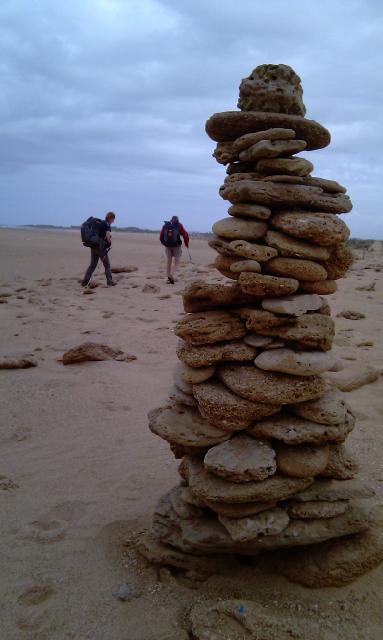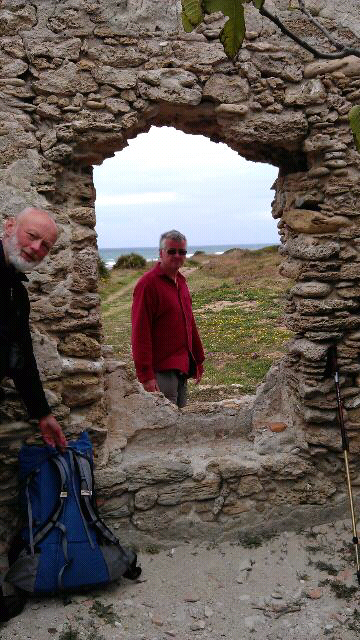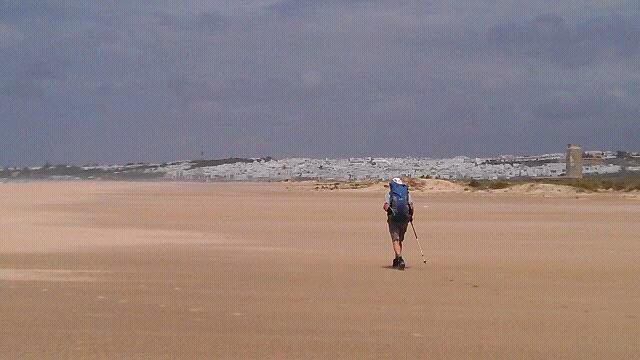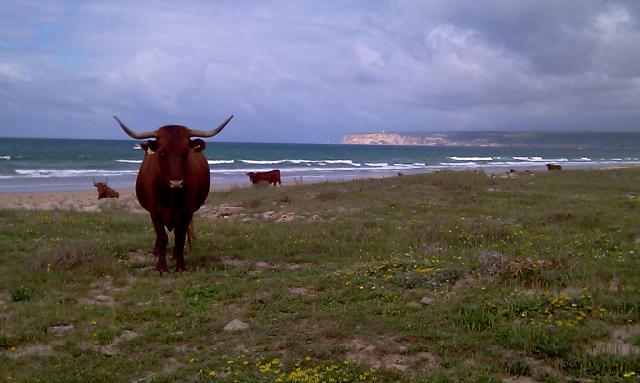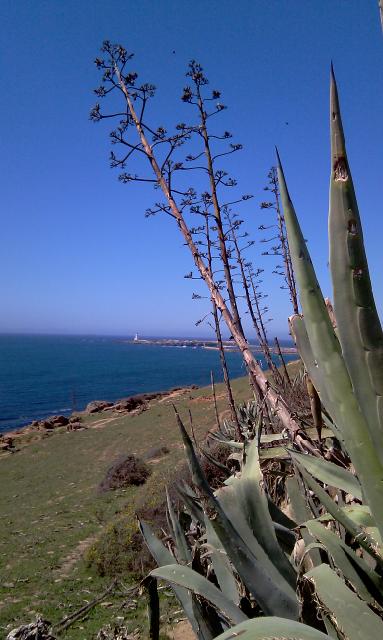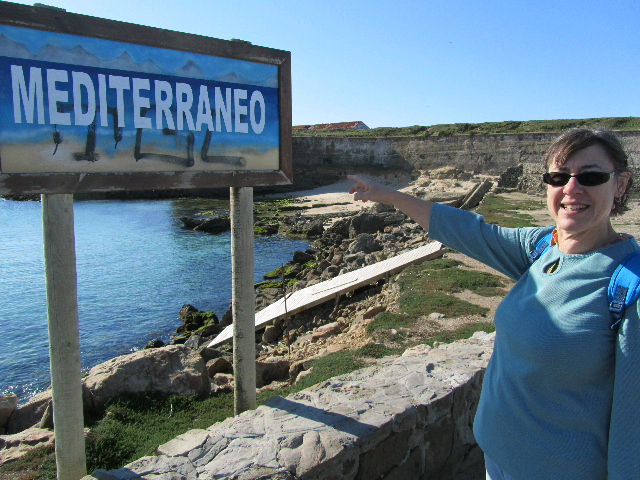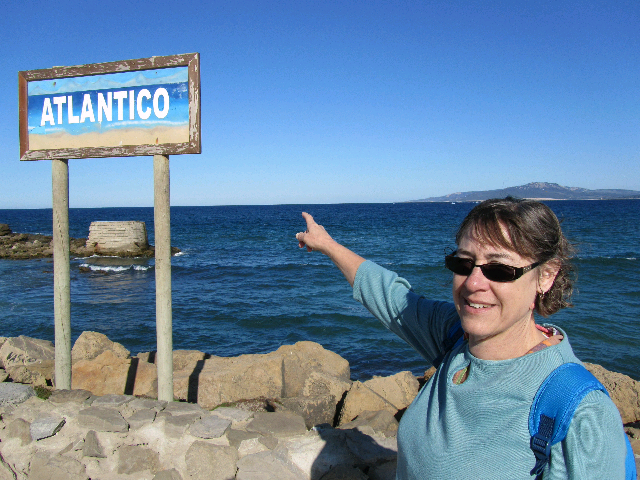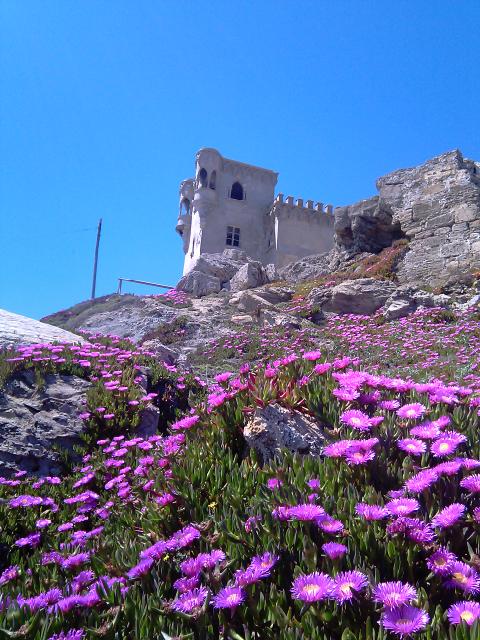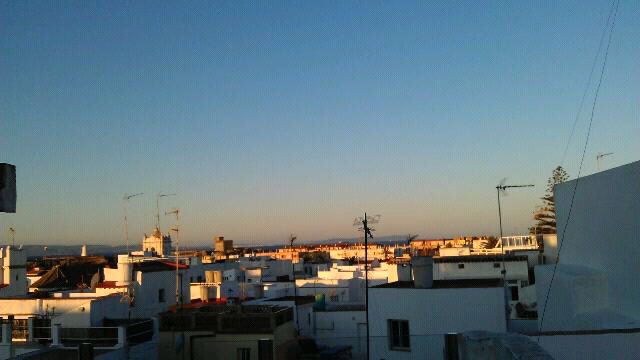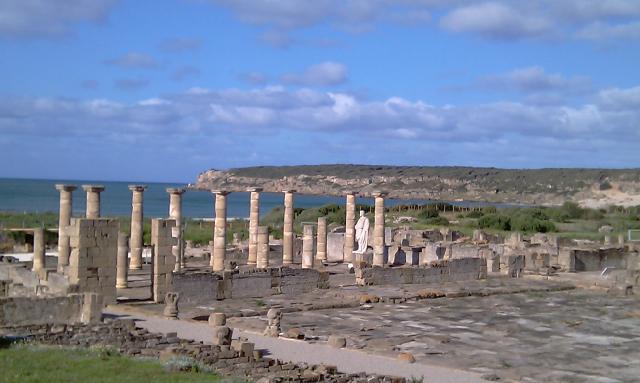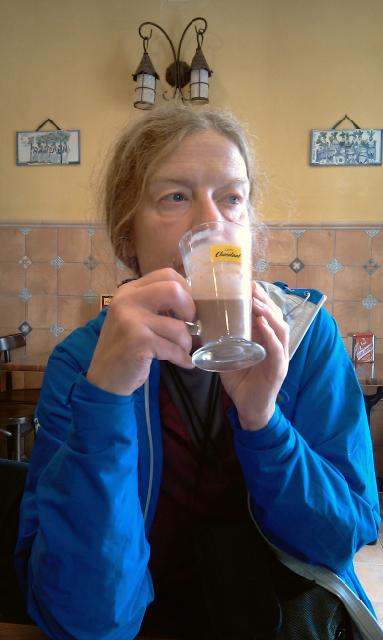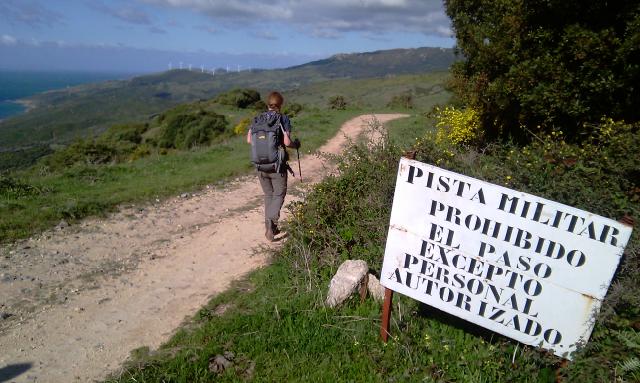19.4.12 Thursday.
We start out from Barbate at about 8.20 after a coffee in a bar near the port, all these here seem to open around 8am or mostly just after. Out of town past the deserted nightclub (sensibly placed a few hundred metres from nearest dwelling and on to the beach for a short hop. Very soon we climb the cliffs we mistook for Cape Trafalgar yesterday and wander through pine wood full of green and goldfinches. The pines were planted late 18th and early 19th century to stabilise the dunes along the length of these small cliffs. As before flowers including orchids are numerous, rain threatens but never really happens to us though patches of sand appear to have recently received it.
We descend from the clifftop forest to Los Ganos de Meca and find another cafe just opening, the couple running it walked to Santiago two years ago and spot the badge on Tony’s rucksac, we get cake as well as coffee!
We now approach the Faro (lighthouse) at Trafalgar, although a headland, Cape Trafalgar is only about 15m above sealevel and is reached by a spit of mixed rock and sand. This is the tombolo, an isthmus thrown up by the action of two opposing sea currents on a promontory similar in the UK to Chesil Beach and Poftland Bill, although here the mix of sediment from the sea’s action is sand and large flatish rocks instead of the regular large pepples we remember from crossing the channel from Weymouth on our first Camino. Some have been piled into cairns across the route.
We continue across the beach/dunes with a little difficulty finding a decent route as building has occured across the Vereda (small drove route) marked on our map, and sand of less than optimal consistency is frequently encountered. We finally meet up with a metalled road again approaching the Torre Nueva (the “not very” new tower) and stop at a beachside bar for beer and tapas about 13.30. The menu is
quite extensive and we go for three tapas, pollo (chicken), carne (meat), both which come with a few fritas however Tim opts for the unknown Ajielas de Huevos, (when it arrives we are no wiser). Tony translates from the internet ajielas as dressing but Betsy swears huevos is eggs and it looks and tastes nothing like egg. Eventually we realise from the faint fishy taste and gritty texture we are eating roe and Betsy’s hard work with the Spanish cds and books is vindicated.
We are now only about 4-5km from Conil our destination but along the beach (the direct route) lies a significant river, the Rio Salado. Google maps suggest this is crossable at low tide on the beach but we have doubts, happily the locals have built a footbridge and we enter Conil de la Frontera in fine style direct from the beach and find lodgings eazily along the front.
24km over 7hours.
Month: April 2012
Walking day 5
Another day at the seaside with a mixture of roads, tracks through dunes and a long stretch just above the water line as we approached Conil. Early in the day we passed a museum of jam – could we have resisted it if it had been open? A ruined house with a view provided shelter from the wind for a few minutes for a rest and a snack.
A stroll on the beach.
18.4.12 Wednesday.
A week since we arrived in Andalusia and Jane has now departed for home, Maurice (the cat), her Brownies and the Ramblers, most (though not all) are not doing as many miles per day as we.
Before setting off for Malaga Airport she dropped us off at the Roman ruins we visited in Bolonia and where our Camino truly begins.
Our route first takes us up over the sand dune at the west end of the beach (claimed to be one of the biggest in europe) just as dawn is breaking, and then down to a nearly 15km stretch of beach. We toil along the sand, in bare feet, boots or sandals according to taste and after a few hundred metres it firms up to a good piste and we scoot along chasing three long legged birds (? Blackwinged Stilts) until we reach Zahara and a mid morning coffee.
Other birds of note spotted during the morning include 2 ostriches (yes, we thought we might be hallucinating too!) and an owl. Most likely a little owl as they are known to be partially diurnal, just out of Zahara after the bridge over the great green greasy Rio Cachon.
The next two hours are a great wander along a track through the littoral area just back from the beach past many wild flowers in bloom and a herd of Andalusian cattle just sitting or standing around on the beach. Cape Trafalgar in the distance gets gradually larger but never arrives.
We reach Barbate just after the cold front forecast for midday arrives on schedule and are seen in a variety of one legged poses donning waterproofs at the side of the causeway into town across La Brena and the Marismas de Barbate (wonderful spanish word not really needing translation).
The town in mid April is largely shut and we think that there would be more (possibly cheaper) accomodation available a little later in the year.
Total distance 22km in five and a half hours.
17.4 Tuesday.
Well another day of relative idleness! We walk back up the coast path a mile or two toward Algeciras and have lunch in a little cove. Tha coast path is flanked by recently flowered agaves with their enormous, but now dead flower spikes. The lighthouse on Isla de la Palomas at Tarifa and the mountains of Morroccp provide a background of white and blue. As well as the usual kestrels we see a flying stork, several warblers probably Sardinian, and Stone and Whin chats.
A pleasant day the walking stats in earnest tomorrow about 8am at Baedio Claudia, the forecast? May be a little damp.
Not the GR10
16.4 Monday
A day of rest during which we walk from Atlantic to Mediterranean, not as in years past by the GR10 but across the causeway to the Isla de las Palomas to actual southerly point at the side of the new ferry terminal. There is, all arround in this town evidence of past strife. The castle of Guzman the Good (not as might be supposed the collegue of Gandalf the Grey) but the first Duke of Medina Sidonia. Those up to speed with their history might recall his descendant (the 7th duke) who headed up the Armada. The gun emplacements built by the British to defend the Isla during the Napoleonic occupation of Iberia. And the Second WW pill boxes next door to the other moorish looking castle of indeterminate age.
Much of the rest of the day we lazed on the roof of the little appartment in the sun and such lack of wind that Tarifa seems to experience. The roofs around the appartment (see Betsy’s pic) give a Peakeish air of Gormengast to the town and it seems much of life on the summer is spent on the cooler roof tops.
Jane will be back off to the UK on Wednesday and the walk will start in earnest, meanwhile we enjoy the sun and rest.
Home sweet home?
Sunday was grey and rainy and yesterday was a day of sand in many states – wet and dry, soft and firm, steep and flat. Not great for long distance walking but very scenic and the wind which lifted it up and sand-blasted our legs also allowed the wind and kite surfers to give us a magnificent demonstration of their skills. Today we can at last appreciate the view from the rooftop of our bijou residence.
15.4 Sunday/Domingo.
Another day walking, we first visit the Roman ruins that are being excavated and sanitised at Baelo Claudia, at Balonia, the huge statue of Tragian (in the Cadiz museum) was excavated from here. The ruins are fairly well preserved and appear to have been a tuna fishing and salting town for the whole empire, as well as a major crossing to the Empire in north africa after Carthage was conquered in the Punic Wars.
We started at 10.40 and covered the 14 miles back to Tarifa in a trifle under 4 hours. Walking on this stretch is both through the chapparal (spanish mediterrnean equivalent of the french marquis) and on the beach. On the streets Tarifa appears to be the kite surfing capital of the world with every other shop selling kite surfers and tuition, today we discovered why as the wind (for them) was apparently perfect. We were impressed by 20ft jumps over 5ft waves as well as the speed and manouvreability of these ?craft.
Walking along the sand is tiring though and we were pleased to finish back at the Isla de Palombie at Tarifa very wind blown and sand blasted.
14.4 Saturday..
Choclate in Cadiz.
Having done two days in one yesterday we declare a tourist day. A visit to Cadiz and a look at towns we will pass while walking. Another reason is the weather forecast (a large wet front around midday).
Good choice we dodge showers in the morning in Cadiz and learn in the excellent museum (free to EU passport holders) that the name Cadir (phoenician) Cades, (roman) has changed little through the ages. Also there a huge statue of Tragian in the Roman section (an emperor who thought a lot of himself) of whom we may hear more later in thos walk, and some quite good art particularly some Impressionists of whom we had never heard (our knowledge is far from exhaustive) who are probably local.
A good lunch in a local bar at 9euro each for 3 courses and a glass of wine, whichi included a large bowl of potato and octopus stew (for Tony and Tim) and scrambled eggs with mushrooms and prawns (for Betsy and Jane). This was preceded (during one of the early downpours) by a quick one in a bar specializing in liquid chocolate.
We had a return to Tarifa in heavy rain and called briefly in to the Roman ruins at Baleo Claudia to check opening hours (previously a major settlement now a very small village) to which we will walk tomorrow along the coast from Tarifa.
13.4.12 Friday.
We are driven to Algeciras by Jane who leaves us with the plan to meet us down at La Costa where the Guadalmer (river/stream) meets the sea. There is some doubt to the existence of a bridge here. We walk up onto the hills west of Algeciras via an old military road discovering the Camino de Algeciras marked with yellow arrows and crosses as usual on the way. All the many signs prohibiting entry to a military area seem to be from a bygone eras and the occasional machine gun post long deserted. The route is beautiful at this time of year with many wild flowers and birds including more shrikes and various falcons as well as goldfinches and warblers.
Alas it is Friday 13th and a text from Jane outlines her difficulty in identifying a road down to our rendezvous, hasty revision of plans occurs leading to a day of 27km instead of 16km and we arrive in Tarifa at 1600hrs after 7hours walking. The coast line in the later stages looks strait across to Morroco and their mobile networks persisted in welcoming us. It has a natural break water of rock strata just off shore protecting the low cliffs.
A great days walking even with repeated hat loss due to the strong headwind.
